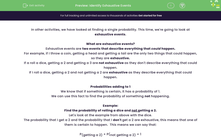In other activities, we have looked at finding a single probability. This time, we're going to look at exhaustive events.
What are exhaustive events?
Exhaustive events are two events that describe everything that could happen.
For example, if I throw a coin, getting a head and getting a tail are the only two things that could happen, so they are exhaustive.
If a roll a dice, getting a 2 and getting a 3 are not exhaustive as they don't describe everything that could happen.
If I roll a dice, getting a 2 and not getting a 2 are exhaustive as they describe everything that could happen.
Probabilities adding to 1
We know that if something is certain, it has a probability of 1.
We can use this fact to find the probability of something not happening.
Example:
Find the probability of rolling a dice and not getting a 2.
Let's look at the example from above with the dice.
The probability that I get a 2 and the probability that I don't get a 2 are exhaustive, this means that one of them is certain to happen. This means we can say that:
P(getting a 2) + P(not getting a 2) = 1
If we rearrange this...
P(not getting a 2) = 1 - P(getting a 2).
This means that if we know the probability of something happening, we can find the probability of it not happening.
P(not getting a 2) = 1 - 1/6 = 5/6
Time for some questions now.








